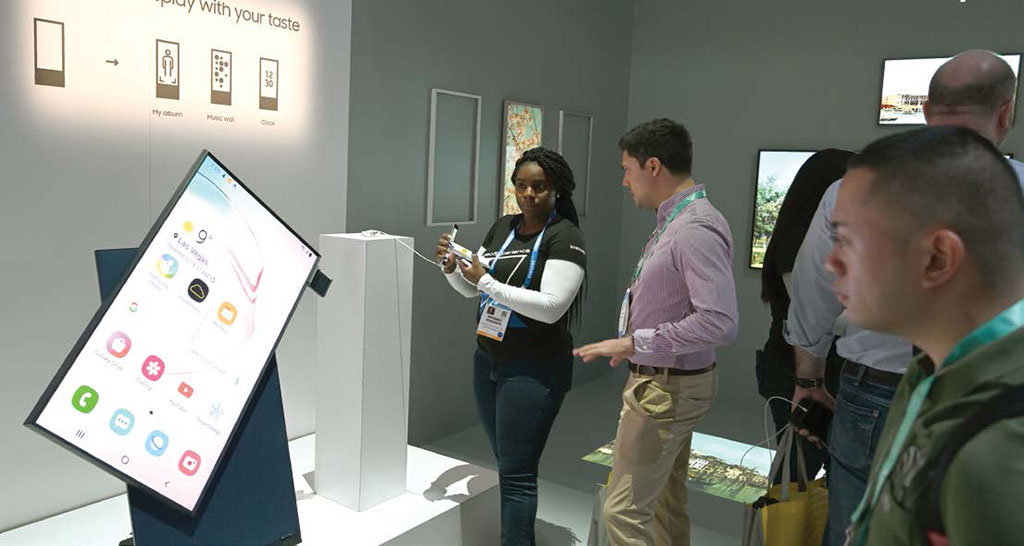TV Still Dazzles at CES
As the world’s largest gathering of consumer electronics technology, the annual Consumer Electronics Show has greatly expanded its focus over the years as more household products become digitized and then connected. The days where TV sets were once the biggest stars are long gone but even today, some of the new entrants at the 2020 show prompted some head scratching.

For example, why would Impossible Foods, one of the world’s largest developers of meat-alternatives be showing at an electronics show? The company used the gala event to roll out their latest experiment in ultra-processed food: fake bacon; nevertheless the connection between their newest concoction and electronics is tangential at best.
Although one could certainly draw a straight line between TV watching and food, the main themes at this year’s show were traditionally consistent with the trends in recent years, namely, 5G, AI, IOT (now referred to as the “intelligence of things”) and for television: 8K.
While sales numbers are still in the single digits for 8K sets worldwide, TV manufacturers were all aboard the high resolution bandwagon at this year’s CES. The fact that there is little to no 8K content available has not deterred manufacturers who claim that their upscaling and display technologies will satisfy consumers’ thirst for the best pictures available.
Concerns over how the variety of televised programming is displayed on their new UHD sets was a priority for the UHD Association, a consortium of studios and set manufacturers promoting high resolution television. Specifically, the association used CES 2020 to formally roll out “Filmmaker Mode,” a setting that will be adopted by most major TV manufacturers to ensure that the correct viewing mode is being used.
As it currently stands, many 4K and 8K sets come out of the box with default modes that don’t necessarily represent how content is to be viewed. Viewers have complained about movies shot in 24 fps being displayed in video mode (aka what has been referred to as “the “soap opera effect”). Needless to say, Hollywood has not been pleased.
“Most people today are watching classic films at home, where existing technology presents all media in exactly the same way, whether it’s a football game or ‘Lawrence of Arabia,’” said director Martin Scorsese. “With Filmmaker Mode, different works will be presented accurately, as they were created and designed by the filmmaker. Filmmaker Mode is a long overdue and welcome innovation.”
Some sets currently on the market offer viewers the ability to activate a “cinema mode” in the TV’s settings, however, Filmmaker Mode will be activated automatically, through metadata embedded in the content. LG, Panasonic and Vizio were among the first set makers to commit to offering it in their 2020 television products; Samsung, Philips/TP Vision, and Kaleidescape will also offer Filmmaker Mode in its TV products this year as well.
Samsung dazzled attendees with its modular “The Wall,” returning to CES this year, offering four new sizes in addition to its largest option—a whopping 292 inches. The Wall includes Samsung’s “MicroLED” screen technology that allows consumers to customize the size of their screens.
Samsung has also upgraded its AI Quantum Processor for its QLED 8K TVs and redesigned the sets in an “ultra-thin” form factor as well introducing its concept of the “Infinity Screen,” which produces a screen-to-body ratio of 99%. LG, as well introduced displays with a 3.5 mm ultra low narrow bezel and providing a wider viewing angle.
But perhaps the TV product that garnered the most buzz was “Sero,” which, with the simple press of a button, rotates to vertical mode to view content created from smartphones. Gone are the vertical bars that characterize the display of vertical videos on horizontal sets.
Our sister brand TechRadar summed up its review of the Sero thusly:
“As a conceptual and cultural piece, the Samsung Sero TV is incredibly interesting. It’s a relic of the internet era, and one that will have a certain appeal to anyone who uses their phone more than their TV. To that end, optimists might say that the Sero could be the bridge that gaps the divide for a younger generation that watches less and less traditional TV while pessimists, very rightly, might just call it a passing fad.”
Once again, CES proves that when it comes to television, there are still no new ideas (or fads) too outlandish to try.
Get the TV Tech Newsletter
The professional video industry's #1 source for news, trends and product and tech information. Sign up below.
Tom has covered the broadcast technology market for the past 25 years, including three years handling member communications for the National Association of Broadcasters followed by a year as editor of Video Technology News and DTV Business executive newsletters for Phillips Publishing. In 1999 he launched digitalbroadcasting.com for internet B2B portal Verticalnet. He is also a charter member of the CTA's Academy of Digital TV Pioneers. Since 2001, he has been editor-in-chief of TV Tech (www.tvtech.com), the leading source of news and information on broadcast and related media technology and is a frequent contributor and moderator to the brand’s Tech Leadership events.

